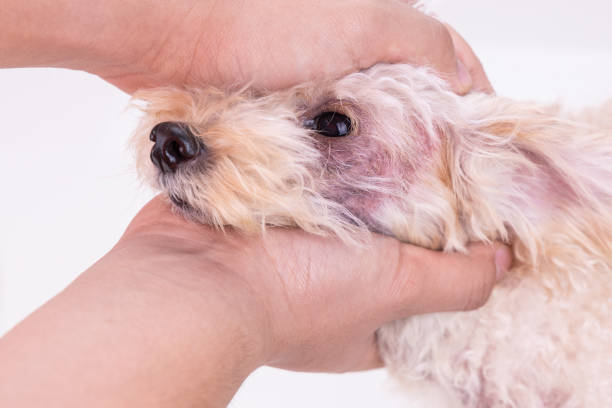Canines, particularly mature ones or those suffering from health problems like diabetes, are vulnerable to infections in their injuries and skin conditions. Given the seriousness of these situations, it’s critical for pet keepers to be informed about their incidence and potential treatments. This piece offers a comprehensive exploration into these topics and more.
Keep an Eye Out for Symptoms of Wound Infection
Several symptoms could be signs that your dog has developed a wound infection: redness or swelling around the area where the treatment was applied, as well as discharge from the wound, open wounds in hot spots (e.g., armpits), licking at the site, and a foul smell from the injury.


Don’t Assume it’s Just a Hot Spot
If your dog has developed what seems like a hot spot – i.e., an area of redness on their skin that appears to be caused by licking or biting at the region – then you’ll want to take them into a veterinary clinic to make sure it isn’t a wound infection. While hot spots generally don’t pose too much of a threat, they can develop into full-blown infections if left untreated.
Not All Wound Infections Are Due to Bacteria
While bacteria are present in most infections, other types of microorganisms can cause them, including viruses and other parasites.


It’s Usually Possible to Treat Wound Infections at Home
If you know what the type of infection is (e.g. your vet diagnoses it after testing several samples), or if it seems like a relatively straightforward case, then it’s usually possible to treat it at home using the following tips. However, if your dog’s infection seems severe or long-lasting, then you should bring them to a veterinary clinic as soon as possible for further tests and treatment.
Wound Infections are More Likely to Occur in Dogs with Diabetes
If your dog has diabetes, they are more likely to develop a wound infection than if they don’t have diabetes. This is because their bodies are already dealing with an increased risk of developing an infection, and damage caused by diabetic neuropathy can make it difficult for wounds to heal quickly and thoroughly.
Treatment may Involve Drug Administration and/or Surgery
Suppose you discover that your dog has developed a wound infection that will require more than just home treatment. In that case, you’ll likely have to take them into a veterinary clinic for further testing and drug administration. This could include one of several antibiotics, depending on the type of infection present. Surgery may also be necessary in some cases to remove any necrotic tissue or foreign bodies causing the infection.


Some Tumors Can Lead to Wound Infections
Sometimes tumours can interfere with wound healing and make it more likely for your dog to develop a full-blown, life-threatening infection. This is particularly true of sarcomas, or tumours that originate in the connective tissue of bones. If your dog has designed a tumour and they’ve also developed an infection, then you should take them to your veterinarian as soon as possible.
This may require that the tumour is surgically removed or partially removed even though it might seem impossible to do so (e.g., due to its location) because doing nothing can cause further infections and more problems for your dog.
It’s a Good Idea to Clean a Wound as Part of the Treatment Process
In some cases, it might be necessary for your vet to clean out an open wound before administering medications or attempting surgery. In some cases, this will involve placing your dog under anaesthesia so that their body can rest as you clean and treat the infection.
Your Vet May Request that You Administer Medications at Home
If your dog is being treated for a severe infection, your vet may want you to administer specific drugs at home. One example is metronidazole, which is often given orally to dogs with an anaerobic bacterial infection in their gut. This will require you to treat your dog with the medication for up to eight weeks before they are healed.
Your Vet Will Want to See You at Follow-Up Visits
Even after an infection has cleared up, your vet must follow up with your dog during future visits so that they can monitor them and ensure that the infection doesn’t reoccur.


Most Common Dog Wound Infection Symptoms
Dogs can suffer from severe infections in their wounds or skin lesions. This is an important topic, especially for pet owners who may not be sure about what signs to look out for. The most common dog wound infection symptoms are:
- Redness
- Swelling
- Pus
- A foul smell coming from the wound or lesion
These indicate that your dog needs professional attention.
Some of the Common Causes of Dog Wound Infections
Many things can cause a dog to develop an infection. If your dog has received stitches after surgery, for example, they may require more care than usual to avoid creating an infection at the site of injury or incision. Another thing that dogs frequently suffer from is skin lesions, which are commonly known as skin tags.
Help Prevent Your Dog from Developing a Wound Infection
There are several things you should make sure your pet has to avoid them getting infected in the first place! For example, dogs (and other pets) need to stay warm and dry after surgery or any other procedure requiring bandages to be used. Using a dressing is usually an essential first step to helping your dog avoid infections, but it’s still vital for you to provide the rest of the things they need on their road to recovery.
Conclusion
Dog wound infections can be dangerous and even life-threatening if left untreated. You may not know what signs to look out for, but we’ve outlined the most common symptoms in this blog post, so you’ll never have to guess again. We hope that these tips help keep your dog healthy and happy!


